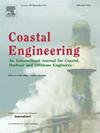On the recession of berm breakwaters
IF 4.5
2区 工程技术
Q1 ENGINEERING, CIVIL
引用次数: 0
Abstract
Berm breakwaters are coastal structures with a rather wide armor layer made of a wide range of stone sizes. These structures are allowed to reshape in response to wave action and as a result, become more stable. Prediction of berm breakwaters' recession is one of the most important tasks in the design of berm breakwaters. Hence, several experimental studies have been carried out on the stability of berm breakwaters and several formulas for predicting the recession are obtained based on them. First, the existing databases were scrutinized to provide a comprehensive databank. Then, it was used to develop a new formula for the berm recession, which includes effects of most important structural characteristics such as front slope, berm height, armor size, density and grading as well as sea state parameters such as wave height, wave period, and water depth. The proposed formula's physical reasoning and accuracy metrics indicated that it outperforms existing formulas, especially in the practical range, i.e., shallow waters with recession between 0.5 and 10 times the armour size. A sensitivity analysis of the Sirevåg berm breakwater was conducted to illuminate the performance of various formulas and the influence of different parameters, Additionally, design recommendations are provided for practitioners.
关于护堤防波堤的退行
护堤防波堤是海岸结构,具有相当宽的装甲层,由各种大小的石头制成。这些结构可以根据波浪作用进行重塑,从而变得更加稳定。防波堤退行预测是防波堤设计的重要内容之一。因此,对护堤防波堤的稳定性进行了多次试验研究,并在此基础上得到了几种预测退潮的公式。首先,审查了现有的数据库,以提供一个全面的数据库。然后,利用它建立了一个新的堤道后退公式,其中包括最重要的结构特征(如前坡度、堤道高度、护甲尺寸、密度和分级)以及海浪高度、波浪周期和水深等海况参数的影响。提出的公式的物理推理和精度指标表明,它优于现有的公式,特别是在实际范围内,即浅水退行在0.5到10倍的装甲尺寸之间。通过对sirev护坡式防波堤的敏感性分析,阐明了各种公式的性能和不同参数的影响,并为设计人员提供了设计建议。
本文章由计算机程序翻译,如有差异,请以英文原文为准。
求助全文
约1分钟内获得全文
求助全文
来源期刊

Coastal Engineering
工程技术-工程:大洋
CiteScore
9.20
自引率
13.60%
发文量
0
审稿时长
3.5 months
期刊介绍:
Coastal Engineering is an international medium for coastal engineers and scientists. Combining practical applications with modern technological and scientific approaches, such as mathematical and numerical modelling, laboratory and field observations and experiments, it publishes fundamental studies as well as case studies on the following aspects of coastal, harbour and offshore engineering: waves, currents and sediment transport; coastal, estuarine and offshore morphology; technical and functional design of coastal and harbour structures; morphological and environmental impact of coastal, harbour and offshore structures.
 求助内容:
求助内容: 应助结果提醒方式:
应助结果提醒方式:


